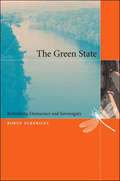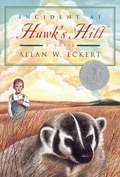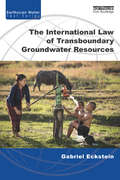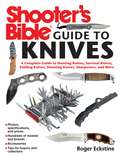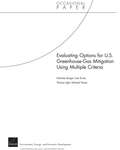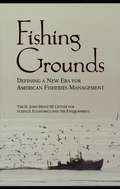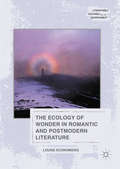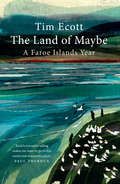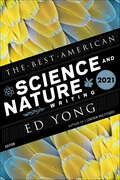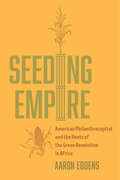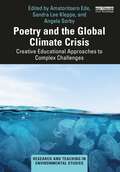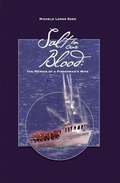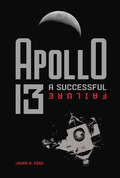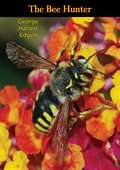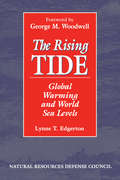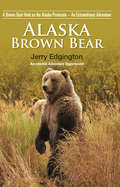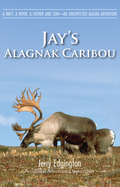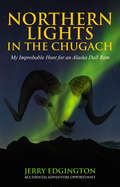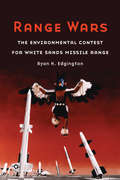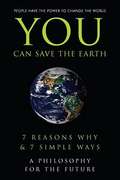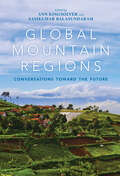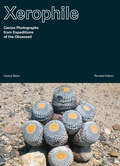- Table View
- List View
The Green State: Rethinking Democracy and Sovereignty
by Robyn EckersleyWhat would constitute a definitively "green" state? In this important new book, Robyn Eckersley explores what it might take to create a green democratic state as an alternative to the classical liberal democratic state, the indiscriminate growth-dependent welfare state, and the neoliberal market-focused state—seeking, she writes, "to navigate between undisciplined political imagination and pessimistic resignation to the status quo." In recent years, most environmental scholars and environmentalists have characterized the sovereign state as ineffectual and have criticized nations for perpetuating ecological destruction. Going consciously against the grain of much current thinking, this book argues that the state is still the preeminent political institution for addressing environmental problems. States remain the gatekeepers of the global order, and greening the state is a necessary step, Eckersley argues, toward greening domestic and international policy and law.The Green State seeks to connect the moral and practical concerns of the environmental movement with contemporary theories about the state, democracy, and justice. Eckersley's proposed "critical political ecology" expands the boundaries of the moral community to include the natural environment in which the human community is embedded. This is the first book to make the vision of a "good" green state explicit, to explore the obstacles to its achievement, and to suggest practical constitutional and multilateral arrangements that could help transform the liberal democratic state into a postliberal green democratic state. Rethinking the state in light of the principles of ecological democracy ultimately casts it in a new role: that of an ecological steward and facilitator of transboundary democracy rather than a selfish actor jealously protecting its territory.
Incident at Hawk's Hill
by Allan W. EckertSix-year-old Ben is very small for his age, and gets along better with animals than people. One June day in 1870, Ben wanders away from his home on Hawk's Hill and disappears into the waving prairie grass. This is the story of how a shy, lonely boy survives for months in the wilds and forges a bond with a female badger. Based on a true story. A Newbery Honor Book.
Wild Season
by Allan W. EckertA story of the living circle of nature Spring. A season of rebirth and struggle, destruction and survival. This is the story of one such spring at a Midwestern lake-a vivid closeup of each animal's fight for life, all under the shadow of the common enemy, Man. Shimmering with the enchantment of the natural world, Wild Season is a triumph of knowledge and love, raising our consciousness and stirring our sense of wonder and respect.
The International Law of Transboundary Groundwater Resources (Earthscan Water Text)
by Gabriel EcksteinThis book provides a comprehensive review of the state of international law as it applies to transboundary groundwater resources and aquifers. The main focus is on recent developments and the emerging international law for transboundary aquifers as reflected in the practice of states and the work of the UN International Law Commission, UN Economic Commission for Europe, and International Law Association. The author takes an interdisciplinary approach to the subject matter and provides the scientific hydro-geological underpinning for the application of law and policy to transboundary groundwater resources. He also addresses the growing global dependence on this hidden resource, as well as both the historical and scientific context for development of the law. The book provides case examples throughout to illustrate the various concepts and developments. These include more detailed examinations of the few existing transboundary aquifer agreements in operation, such as for aquifers between France and Switzerland and Jordan and Saudi Arabia, as well as aquifers in North Africa and in South America.
Shooter's Bible Guide to Knives: A Complete Guide to Fixed and Folding Blade Knives for Hunting, Survival, Personal Defense, and Everyday Carry
by Roger EckstineIdeal for fans of buck knives, razor blade knives, elephant knives, and other knivesOne of many reputable Shooter’s Bible booksThorough resource for all of the listings and current trends in the knife market, including new manufacturers and metals The Shooter’s Bible Guide to Knives contains everything you need to know about owning, maintaining, and buying all kinds of knives. It sets the basic standard for thorough publications by continuing the Shooter’s Bible tradition of compiling more information and products than any other source. It belongs on bookshelves with other knife collecting books, knives books, firearms survival guides, and top knife books. It is also a classic shooter book. This book contains photographs and descriptions of more than 400 knives that treat readers to product highlights from custom knife makers and major manufacturers. It takes you from the blacksmith shop to high-tech influential designers with new information about locking mechanisms, blade steel, and handle materials. It has an encyclopedic level of information, including: Tips for buyers and collectorsDetailed specifications and pricesKnives for self-defenseKnife anatomyAccessories and sharpenersLegal knowledge for every knife ownerSkyhorse Publishing is proud to publish a broad range of books for hunters and firearms enthusiasts. We publish books about shotguns, rifles, handguns, target shooting, gun collecting, self-defense, archery, ammunition, knives, gunsmithing, gun repair, and wilderness survival. We publish books on deer hunting, big game hunting, small game hunting, wing shooting, turkey hunting, deer stands, duck blinds, bowhunting, wing shooting, hunting dogs, and more. While not every title we publish becomes a New York Times bestseller or a national bestseller, we are committed to publishing books on subjects that are sometimes overlooked by other publishers and to authors whose work might not otherwise find a home.
Shooter's Bible Guide to Knives: A Complete Guide to Hunting Knives Survival Knives Folding Knives Skinning Knives Sharpeners and More
by Roger EckstineThe new Shooter's Bible Guide to Knives sets the standard for comprehensive publications by carrying on the Shooter's Bible tradition of bringing together more products and information than any other source. With photographs and descriptions of more than 400 knives, readers are treated to product highlights from major manufacturers and custom knife makers. This book brings you from the blacksmith shop to high tech influential designers with insights into blade steel, locking mechanisms, and handle materials. When it comes to knives, this book is the source for the products and the passion.
Evaluating Options for U.S. Greenhouse-Gas Mitigation Using Multiple Criteria
by Liisa Ecola Michael Toman Thomas Light Nicholas BurgerChoosing policy responses to mitigate greenhouse gases (GHGs) is one of the great challenges that the United States faces. It will require balancing cost-effectiveness and other objectives that reflect the institutional and political realities of passing major federal legislation with widespread impacts on U.S. producers and consumers. This paper develops a framework for evaluating U.S. GHG-mitigation policy that balances several criteria.
Fishing Grounds: Defining A New Era For American Fisheries Management
by Economics, and the Environment The H. John Heinz III Center for ScienceFisheries management today is highly contentious. The interests of fishers and fish processors, coastal communities, the government, and environmental organizations are often different and can even be mutually incompatible.Fishing Grounds offers a comprehensive assessment of the legal, social, economic and biological context of marine fisheries management in the United States. Drawing on interviews with stakeholders from all sides of the issue, the authors seek common ground -- and points of unresolved controversy -- among the diversity of interests and viewpoints involved. Chapters examine: history and background status of marine fisheries fishery productivity from biological, social, and economic perspectives ownership of fishery resources management structures and incentives the roles of science and evaluation Each chapter begins with legal, technical, and conceptual background to help readers understand the sets of issues involved and follows that with a balanced presentation of stakeholder views.Fishing Grounds presents a useful overview of fisheries management options and positions regarding those options, providing valuable insight into the opinions and concerns of stakeholders and the sets of incentives to which those stakeholders respond. It is an important work for fisheries management professionals in industry, government agencies, and nongovernmental organizations, as well as for students and researchers involved with fisheries and fisheries management.
The Ecology of Wonder in Romantic and Postmodern Literature
by Louise EconomidesThis book traces the aesthetic of wonder from the romanticperiod through contemporary philosophy and literature, arguing for itsrelevance to ecological consciousness. Most ecocritical scholarship tends toovershadow discussions of wonder with the sublime, failing to treat these twoaesthetic categories as distinct. As a result, contemporary scholarship hasconflated wonder and the sublime and ultimately lost the nuances that these twoconcepts conjure for readers and thinkers. Economides illuminates importantdifferences between these aesthetics, particularly their negotiation of issuesrelevant to gender-based and environmental politics. In turn, readers canutilize the concept of wonder as an open-ended, non-violent framework incontrast to the ethos of domination that often surrounds the sublime.
The Land of Maybe: A Faroe Islands Year
by Tim EcottFollowing the natural cycle of the year, The Land of Maybe captures the essence of the 18 mysterious Faroe Islands in the North Atlantic. Here, a fast disappearing world is home to a close-knit society where just 50,000 people share Viking roots and a unique language. Buffeted by the elements in a volatile environment, the Faroese still hunt seabirds, herd pilot whales and eat mutton fermented in the salt winds that howl across dark fjords. A passionate naturalist, Ecott immerses himself in this starkly beautiful landscape, revealing a way of life that maintains a deep connection to the past. The Land of Maybe offers a refuge from the freneticism of the modern world, and confronts some of the biggest challenges we face in trying to live in peace with nature.
The Best American Science And Nature Writing 2021 (The Best American Series)
by Ed Yong, Jaime GreenNew York Times best-selling author and renowned science journalist Ed Yong compiles the best science and nature writing published in 2020. &“The stories I have chosen reflect where I feel the field of science and nature writing has landed, and where it could go,&” Ed Yong writes in his introduction. &“They are often full of tragedy, sometimes laced with wonder, but always deeply aware that science does not exist in a social vacuum. They are beautiful, whether in their clarity of ideas, the elegance of their prose, or often both.&” The essays in this year&’s Best American Science and Nature Writing brought clarity to the complexity and bewilderment of 2020 and delivered us necessary information during a global pandemic. From an in-depth look at the moment of the virus&’s outbreak, to a harrowing personal account of lingering Covid symptoms, to a thoughtful analysis on how the pandemic will impact the environment, these essays, as Yong says, &“synthesize, evaluate, dig, unveil, and challenge,&” imbuing a pivotal moment in history with lucidity and elegance. THE BEST AMERICAN SCIENCE AND NATURE WRITING 2021 INCLUDES • SUSAN ORLEAN • EMILY RABOTEAU • ZEYNEP TUFEKCI • HELEN OUYANG • HEATHER HOGAN BROOKE JARVIS • SARAH ZHANG and others
Seeding Empire: American Philanthrocapital and the Roots of the Green Revolution in Africa
by Aaron EddensIn Seeding Empire, Aaron Eddens rewrites an enduring story about the past—and future—of global agriculture. Eddens connects today's efforts to cultivate a "Green Revolution in Africa" to a history of American projects that introduced capitalist agriculture across the Global South. Expansive in scope, this book draws on archival records of the earliest Green Revolution projects in Mexico in the 1940s and 1950s, as well as interviews at development institutions and agribusinesses working to deliver genetically modified crops to millions of small-scale farmers across Africa. From the offices of the Bill and Melinda Gates Foundation to the halls of the world's largest agricultural biotechnology companies to field trials of hybrid maize in Kenya, Eddens shows how the Green Revolution fails to address global inequalities. Seeding Empire insists that eradicating hunger in a world of climate crisis demands thinking beyond the Green Revolution.
Poetry and the Global Climate Crisis: Creative Educational Approaches to Complex Challenges (Research and Teaching in Environmental Studies)
by Amatoritsero Ede Sandra Lee Kleppe Angela SorbyThis book demonstrates how humans can become sensitized to, and intervene in, environmental degradation by writing, reading, analyzing, and teaching poetry. It offers both theoretical and practice-based essays, providing a diversity of approaches and voices that will be useful in the classroom and beyond. The chapters in this edited collection explore how poetry can make readers climate-ready and climate-responsive through creativity, empathy, and empowerment. The book encompasses work from or about Oceania, Africa, Europe, North America, Asia, and Antarctica, integrating poetry into discussions of specific local and global issues, including the value of Indigenous responses to climate change; the dynamics of climate migration; the shifting boundaries between the human and more-than-human world; the ecopoetics of the prison-industrial complex; and the ongoing environmental effects of colonialism, racism, and sexism. With numerous examples of how poetry reading, teaching, and learning can enhance or modify mindsets, the book focuses on offering creative, practical approaches and tools that educators can implement into their teaching and equipping them with the theoretical knowledge to support these. This volume will appeal to educational professionals engaged in teaching environmental, sustainability, and development topics, particularly from a humanities-led perspective.
Salt in Our Blood: The Memoir of a Fisherman's Wife
by Michele Longo EderIn 2000, Michele Longo Eder began a journal to record what daily life was like for her while her husband and sons were out commercial fishing off the coasts of Oregon, Washington, and northern California. But personal tragedy struck just before Christmas 2001. This book is an offer of healing to her family, her community, and to fishing families everywhere.
The Gate to Golf
by J Douglas EdgarJames Douglas Edgar (1884-1921) was an English professional golfer and golf writer. He won the French Open in 1914. The Gate to Golf was based on his discoveries made in England. Edgar had an ailing hip which he could not turn freely. Through a series of experiments, he found that a restricted hip turn still allowed a repeatable swing with excellent power and control. This book proved to have significant impact on golf instruction, right up to the present time. Illustrated with photos displaying the technique described in the text.—Print ed.
Apollo 13: A Successful Failure
by Laura B. Edge"Houston, we've had a problem." On April 13, 1970, the three astronauts aboard the Apollo 13 spacecraft were headed to the moon when a sudden explosion rocked the ship. Oxygen levels began depleting rapidly. Electrical power began to fail. Astronauts James Lovell, Jack Swigert, and Fred Haise were about to be stranded in the inky void of outer space. The mission to the moon was scrapped. Now, Apollo 13's only goal was to bring the crew home. With the damaged spacecraft hurtling towards the moon at roughly six thousand miles per hour, there was little hope of success. But the astronauts and mission control were fully prepared to do whatever it took to return the crew to Earth. This space disaster occurred at the peak of the United States' Space Race against the Soviet Union. But for four days in 1970, the two nations put aside their differences, and the entire world watched the skies, hoping and praying the astronauts would return safely. As missions to Mars and commercial space flight become a reality, the time is now to be reminded of our common humanity, of how rivals can work together and support each other towards a shared goal. Because no matter what happens or where we travel, we all call Earth home.
The Bee Hunter
by George Harold EdgellOriginally published in 1949, this amusing and informative little book gives a charming account of an avocation seriously pursued by the author for fifty summers. It provides as well, with clarity and wit, a manual for lovers of nature (and wild honey) who might wish to undertake this ingenious sport. George Harold Edgell sticks his neck out on the first page and says no other book describing the proper approach to wild bees exists. “It is time,” he says, “for someone who has hunted bees and found bee trees to write the facts.”
The Rising Tide: Global Warming And World Sea Levels
by Lynne EdgertonThe Rising Tide is the first analysis of global warming and world sea level rise. It outlines state, national, and international actions to respond to the effects of global warming on coastal communities and ecosystems.
Alaska Brown Bear: A Brown Bear Hunt on the Alaska Peninsula – An Extraordinary Adventure
by Jerry EdgingtonFew experiences in life are true adventures; even fewer are truly extraordinary. Rarely, very rarely are they both; where the past and the future collide in an unforgettable present moment. Where the senses, the intellect and the spirit and harmony in the experience. I hadn't imagined that an Alaska Peninsula bear hunt would be one of those adventures. I've experienced moments of truth when hunting—the rush of spotting game, the stalk, and the shot. But that changed on this hunt. Connecting to the transcendent silence of Alaska, nature as pure as it comes; that became my real moment of truth. It became my real world, more than the one I had le behind. My bear hunt was more than I expected and maybe more than I was prepared for, but not more than I wanted, or needed, and in the end it had little to do with getting a bear.
Jay's Alagnak Caribou: A Raft, A River, A Father and Son—An Unexpected Alaska Adventure
by Jerry EdgingtonJay and his dad knew things would change after summer. The seasons of boy scouts, little league, high school sports, and just hanging out, would be gone forever. But there was a chapter left to write, and it would be written on a long section of the Alagnak River in Alaska. It wouldn't be the final chapter, not by a long stretch, but it would be a transcending chapter. A self-guided moose hunt and fishing trip would be a proper way to commemorate Jay's 19th birthday. So, with fishing rods and guns, and a flight into the headwaters of the Alagnak River they embarked on their adventure. What they found was more than they imagined—much more. They found the Alaska wilderness and a freedom they didn't know existed. They found a life changing adventure—built unbreakable bonds.
Northern Lights in the Chugach: My Improbable Hunt for an Alaska Dall Ram
by Jerry EdgingtonMy hunt for a Dall ram in the Chugach Mountains of Alaska became an epic adventure and stretched me beyond my limits, or so I thought. High on the rocky face of a steep mountainside, I found myself both physically and mentally spent. Exhaustion and confusion are a dangerous combination in a spot like that. Sweat stung my eyes and ran off my nose. My heartbeat pulsed in my ears and my arms and legs were limp with fatigue. I reached deep for a little more grit and climbed on. At the top of the next pitch I found a flat section of grass about the length of my body, an oasis and a reprieve from the misery. Life altering epiphanies come at a price. Amid the northern nights in the Chugach Mountains I found a bigger world than I'd ever known.
Range Wars: The Environmental Contest for White Sands Missile Range
by Ryan H. EdgingtonEstablished in south-central New Mexico at the end of World War II, White Sands Missile Range is the largest overland military reserve in the western hemisphere. It was the site of the first nuclear explosion, the birthplace of the American space program, and the primary site for testing U.S. missile capabilities.In this environmental history of White Sands Missile Range, Ryan H. Edgington traces the uneasy relationships between the military, the federal government, local ranchers, environmentalists, state game and fish personnel, biologists and ecologists, state and federal political figures, hunters, and tourists after World War II—as they all struggled to define and productively use the militarized western landscape. Environmentalists, ranchers, tourists, and other groups joined together to transform the meaning and uses of this region, challenging the authority of the national security state to dictate the environmental and cultural value of a rural American landscape. As a result, White Sands became a locus of competing geographies informed not only by the far-reaching intellectual, economic, and environmental changes wrought by the cold war but also by regional history, culture, and traditions.
You Can Save The Earth: A Philosophy For The Future
by June EdingWith a fresh, philosophical approach, this work outlines simple and rewarding ways individuals can take action for the good of the Earth--and themselves.
Global Mountain Regions: Conversations toward the Future (Framing the Global)
by Edited by Ann Kingsolver and Sasikumar BalasundaramWorks exploring the responses of global mountain communities to the shared challenges and opportunities their unique locations afford them.No matter where they are located in the world, communities living in mountain regions have shared experiences defined in large part by contradictions. These communities often face social and economic marginalization despite providing the lumber, coal, minerals, tea, and tobacco that have fueled the growth of nations for centuries. They are perceived as remote and socially inferior backwaters on one hand while simultaneously seen as culturally rich and spiritually sacred spaces on the other. These contradictions become even more fraught as environmental changes and political strains place added pressure on these mountain communities. Shifting national borders and changes to watersheds, forests, and natural resources play an increasingly important role as nations respond to the needs of a global economy.The works in this volume consider multiple nations, languages, generations, and religions in their exploration of upland communities’ responses to the unique challenges and opportunities they share. From paintings to digital mapping, environmental studies to poetry, land reclamation efforts to song lyrics, the collection provides a truly interdisciplinary and global study. The editors and authors offer a cross-cultural exploration of the many strategies that mountain communities are employing to face the concerns of the future.“Global Mountain Regions is an outstanding addition to the inventory of the interdisciplinary field of montology, the study of mountains. For any scholar or student interested in the human dimensions of mountain regions, many if not all of the essays will be valuable references.” —American Ethnologist
Xerophile, Revised Edition: Cactus Photographs from Expeditions of the Obsessed
by Edited by Cactus StoreAn updated edition of the cult classic, featuring stunning archival photographs of hundreds of the rarest and most spectacular plants on Earth, taken by a motley crew of cactus obsessives &“A catalogue of wonders that most of us will never get to see in person.&”—The New YorkerFrom the people behind Cactus Store comes Xerophile, a photographic collection of these improbable desert wonders in the wild. Drawing on the archives of twenty-five cactus obsessives—from PhD botanist to banker, art teacher to cancer researcher—this revised edition spans eighty years and features new and expanded descriptive notes for all 350+ photos.Xerophile brings together eighty years&’ worth of these explorers&’ remarkable images from some of the world&’s most remote habitats: a peculiar two-leaved plant that lives for millennia in the deserts of Namibia; succulents whose poisonous sap is used by hunters to fell large game in Angola; and cactus that live on snow-covered mountains in Bolivia, sink below ground level to survive droughts in Mexico, are pollinated by bats in Brazil, and grow in pure lava fields of the Galápagos Islands.
